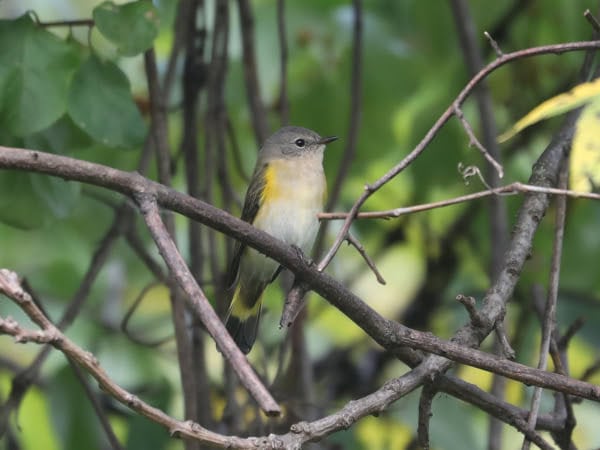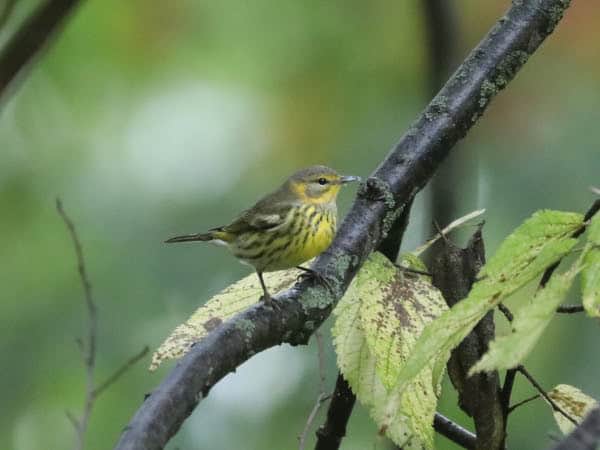Migrants Departing: American Redstarts and Cape May Warblers
The peak of this year’s fall songbird migration has now passed, but there are still some beautiful birds passing through. I photographed these two warblers last week at Wizard Ranch Nature Preserve, which is managed by the Lancaster Conservancy. There was so much bird activity there that I never got more than a few hundred feet from the parking area. Many of our small, insect-eating birds leave during the winter for the Tropics, where insects are abundant year-round.
With an estimated breeding population of 1.5 million, American Redstarts are the fourth most abundant of Pennsylvania’s nesting warblers. The only warblers with larger breeding populations are the Ovenbird (3.2 million), Common Yellowthroat (2.4 million), and Yellow Warbler (1.6 million). As winter approaches, they are migrating to northern South America, Central America, and most Caribbean Islands.
Unlike redstarts, Cape May Warblers do not nest in Pennsylvania at all. During the summer, the closest breeding population of Cape May Warblers is in the Adirondack Mountains of northern New York, but almost all members of this species nest farther north in Canada. They appear briefly in the Susquehanna Valley each year in the spring and fall. They also appear briefly in Cape May, New Jersey, the town after which they were named. Most of them spend the winter in the Caribbean, especially Cuba, Hispaniola, the Bahamas, and the Florida Keys.
Even though most warblers are only with us for a small portion of the year, we can still help them by planting native plants to provide them with more food during their journey. Use decals on the outside of your windows to break up their reflection and keep your windows safe for birds. Also, keep in mind that many of our migratory songbirds live in the winter where coffee is grown, so you can support their winter habitat with Smithsonian-certified Bird Friendly Coffee.
Migrants Departing: American Redstarts and Cape May Warblers
The peak of this year’s fall songbird migration has now passed, but there are still some beautiful birds passing through. I photographed these two warblers last week at Wizard Ranch Nature Preserve, which is managed by the Lancaster Conservancy. There was so much bird activity there that I never got more than a few hundred feet from the parking area. Many of our small, insect-eating birds leave during the winter for the Tropics, where insects are abundant year-round.
With an estimated breeding population of 1.5 million, American Redstarts are the fourth most abundant of Pennsylvania’s nesting warblers. The only warblers with larger breeding populations are the Ovenbird (3.2 million), Common Yellowthroat (2.4 million), and Yellow Warbler (1.6 million). As winter approaches, they are migrating to northern South America, Central America, and most Caribbean Islands.
Unlike redstarts, Cape May Warblers do not nest in Pennsylvania at all. During the summer, the closest breeding population of Cape May Warblers is in the Adirondack Mountains of northern New York, but almost all members of this species nest farther north in Canada. They appear briefly in the Susquehanna Valley each year in the spring and fall. They also appear briefly in Cape May, New Jersey, the town after which they were named. Most of them spend the winter in the Caribbean, especially Cuba, Hispaniola, the Bahamas, and the Florida Keys.
Even though most warblers are only with us for a small portion of the year, we can still help them by planting native plants to provide them with more food during their journey. Use decals on the outside of your windows to break up their reflection and keep your windows safe for birds. Also, keep in mind that many of our migratory songbirds live in the winter where coffee is grown, so you can support their winter habitat with Smithsonian-certified Bird Friendly Coffee.
About The Author
Dan Hinnebusch is the Ornithologist for Wild Birds Unlimited. Click to learn more.





